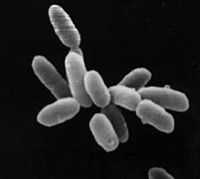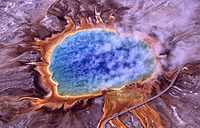Gene transcriptions/Elements/Factor II B recognition
< Gene transcriptions < Elements
"The B recognition element (BRE) is a DNA sequence found in the promoter region of most genes in eukaryotes and Archaea.[1][2]"[3]
"The BRE is a cis-regulatory element that is found immediately upstream of the TATA box, and consists of 7 nucleotides."[3]
In the archaean from the Dead Sea imaged at the right, "We have completely fragmented their DNA. I mean we have completely destroyed it by bombarding it with [radiation]. And they can reassemble their entire chromosome and put it back into working order within several hours."[4]
Consensus sequences

The consensus sequence is 5’-G/C G/C G/A C G C C-3’.[5]
The general consensus sequence using degenerate nucleotides is 5’-SSRCGCC-3’, where S = G or C and R = A or G.[6]
Transcription start sites
"The position in nucleotides (nt) relative to the transcription start site (TSS, +1)" is -35 for the BRE. Of human promoters, some "22-25% [are] BRE containing promoters ... the functional consensus sequences for BRE ... motif [is] still poorly defined."[6]
General transcription factor II Bs
"The Transcription Factor IIB (TFIIB) recognizes this sequence in the DNA, and binds to it. The fourth and fifth alpha helices of TFIIB intercalate with the major groove of the DNA at the BRE. TFIIB is one part of the preinitiation complex that helps RNA Polymerase II bind to the DNA."[3]
Research
Hypothesis:
- B recognition factor is not involved in the transcription of A1BG.
Control groups

The findings demonstrate a statistically systematic change from the status quo or the control group.
“In the design of experiments, treatments [or special properties or characteristics] are applied to [or observed in] experimental units in the treatment group(s).[7] In comparative experiments, members of the complementary group, the control group, receive either no treatment or a standard treatment.[8]"[9]
Proof of concept
Def. a “short and/or incomplete realization of a certain method or idea to demonstrate its feasibility"[10] is called a proof of concept.
Def. evidence that demonstrates that a concept is possible is called proof of concept.
The proof-of-concept structure consists of
- background,
- procedures,
- findings, and
- interpretation.[11]
See also
References
- ↑ Lagrange T, Kapanidis AN, Tang H, Reinberg D, Ebright RH (1998). "New core promoter element in RNA polymerase II-dependent transcription: sequence-specific DNA binding by transcription factor IIB". Genes & Development 12 (1): 34–44. doi:10.1101/gad.12.1.34. PMID 9420329. PMC 316406. //www.ncbi.nlm.nih.gov/pmc/articles/PMC316406/.
- ↑ Littlefield O, Korkhin Y, Sigler PB (1999). "The structural basis for the oriented assembly of a TBP/TFB/promoter complex". Proceedings of the National Academy of Sciences of the USA 96 (24): 13668–73. doi:10.1073/pnas.96.24.13668. PMID 10570130. PMC 24122. //www.ncbi.nlm.nih.gov/pmc/articles/PMC24122/.
- 1 2 3 "B recognition element, In: Wikipedia". San Francisco, California: Wikimedia Foundation, Inc. January 30, 2013. Retrieved 2013-01-30.
- ↑ Adrienne Kish (September 10, 2004). "Secrets of a Salty Survivor A microbe that grows in the Dead Sea is teaching scientists about the art of DNA repair". Washington, DC USA: NASA. Retrieved 2014-05-15.
- ↑ Alan K. Kutach, James T. Kadonaga (July 2000). "The Downstream Promoter Element DPE Appears To Be as Widely Used as the TATA Box in Drosophila Core Promoters". Molecular and Cellular Biology 20 (13): 4754-64. PMID 10848601. http://www.ncbi.nlm.nih.gov/pmc/articles/PMC85905/pdf/mb004754.pdf. Retrieved 2012-07-15.
- 1 2 Chuhu Yang, Eugene Bolotin, Tao Jiang, Frances M. Sladek, Ernest Martinez. (March 7, 2007). "Prevalence of the initiator over the TATA box in human and yeast genes and identification of DNA motifs enriched in human TATA-less core promoters". Gene 389 (1): 52-65. doi:10.1016/j.gene.2006.09.029. PMID 17123746. http://www.ncbi.nlm.nih.gov/pmc/articles/PMC1955227/?tool=pubmed.
- ↑ Klaus Hinkelmann, Oscar Kempthorne (2008). Design and Analysis of Experiments, Volume I: Introduction to Experimental Design (2nd ed.). Wiley. ISBN 978-0-471-72756-9. http://books.google.com/?id=T3wWj2kVYZgC&printsec=frontcover.
- ↑ R. A. Bailey (2008). Design of comparative experiments. Cambridge University Press. ISBN 978-0-521-68357-9. http://www.cambridge.org/uk/catalogue/catalogue.asp?isbn=9780521683579.
- ↑ "Treatment and control groups, In: Wikipedia". San Francisco, California: Wikimedia Foundation, Inc. May 18, 2012. Retrieved 2012-05-31.
- ↑ "proof of concept, In: Wiktionary". San Francisco, California: Wikimedia Foundation, Inc. November 10, 2012. Retrieved 2013-01-13.
- ↑ Ginger Lehrman and Ian B Hogue, Sarah Palmer, Cheryl Jennings, Celsa A Spina, Ann Wiegand, Alan L Landay, Robert W Coombs, Douglas D Richman, John W Mellors, John M Coffin, Ronald J Bosch, David M Margolis (August 13, 2005). "Depletion of latent HIV-1 infection in vivo: a proof-of-concept study". Lancet 366 (9485): 549-55. doi:10.1016/S0140-6736(05)67098-5. http://www.ncbi.nlm.nih.gov/pmc/articles/PMC1894952/. Retrieved 2012-05-09.
Further reading
- Chuhu Yang, Eugene Bolotin, Tao Jiang, Frances M. Sladek, Ernest Martinez. (March 7, 2007). "Prevalence of the initiator over the TATA box in human and yeast genes and identification of DNA motifs enriched in human TATA-less core promoters". Gene 389 (1): 52-65. doi:10.1016/j.gene.2006.09.029. PMID 17123746. http://www.ncbi.nlm.nih.gov/pmc/articles/PMC1955227/?tool=pubmed.
External links
- African Journals Online
- Bing Advanced search
- GenomeNet KEGG database
- Google Books
- Google scholar Advanced Scholar Search
- Home - Gene - NCBI
- JSTOR
- Lycos search
- NCBI All Databases Search
- Office of Scientific & Technical Information
- PubChem Public Chemical Database
- Questia - The Online Library of Books and Journals
- SAGE journals online
- Scirus for scientific information only advanced search
- SpringerLink
- Taylor & Francis Online
- WikiDoc The Living Textbook of Medicine
- Wiley Online Library Advanced Search
- Yahoo Advanced Web Search
| |||||||||||||||||||||||||||||||||||||||||
| |||||||||||||||||||||||||||||||||||
![]() This is a research project at http://en.wikiversity.org
This is a research project at http://en.wikiversity.org
| |
Development status: this resource is experimental in nature. |
| |
Educational level: this is a research resource. |
| |
Resource type: this resource is an article. |
| |
Resource type: this resource contains a lecture or lecture notes. |
| |
Subject classification: this is a biochemistry resource. |
| |
Subject classification: this is a genetics resource. |